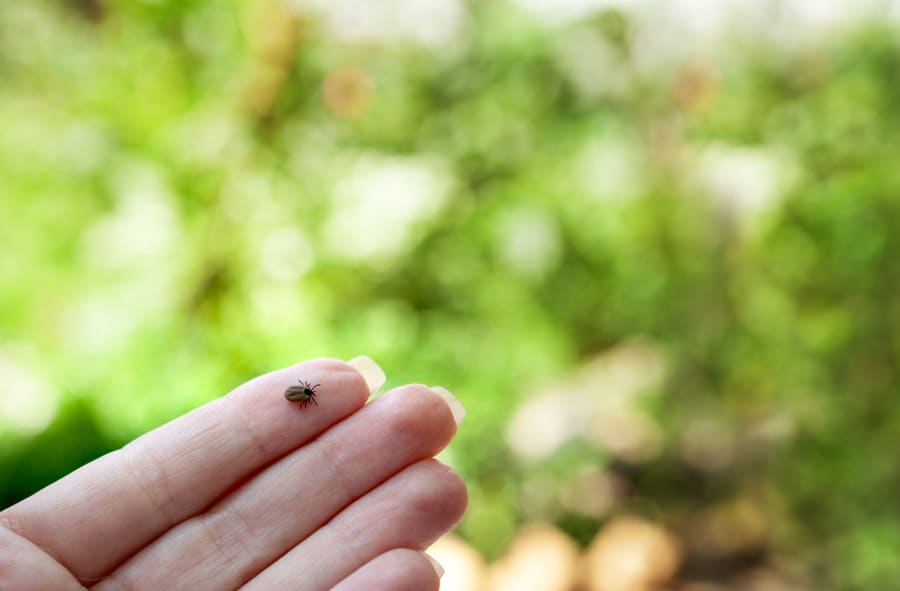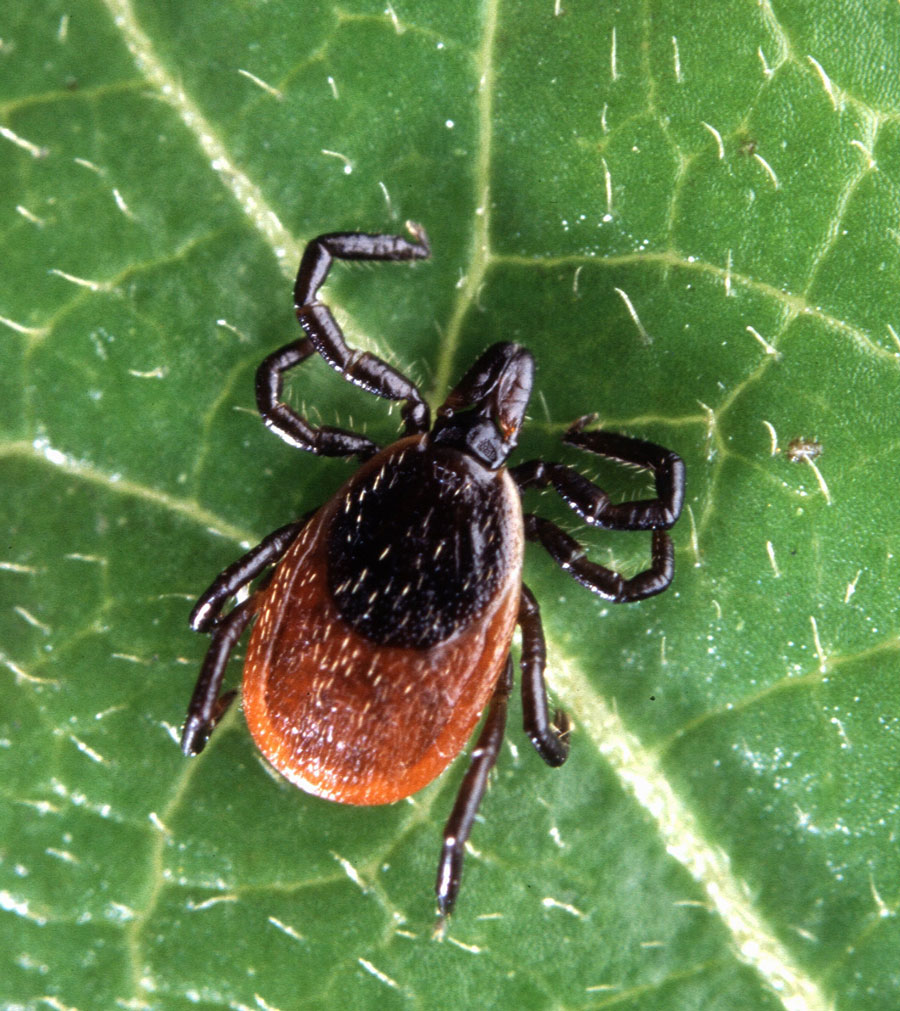Alpha-Gal syndrome Trade-off between allergy and protection to infectious diseases
Throughout the natural world there are countless essential interactions between hosts, vectors and pathogens. Vectors carry and transmit microorganisms that cause disease, known as pathogens, and hosts are affected by the pathogen. A common example of this process is the Lyme disease-tick-human relationship where Lyme disease caused by the pathogenic bacterium Borrelia burgdorferi is carried and transmitted by the tick vector to the human host.
The tick affects humans and other animals by biting them, infecting them with pathogens. Tick saliva contains both toxic and pharmacologically active substances which can trigger inflammatory reactions. Environmental factors and increasing levels of human outdoor activities have resulted in greater levels of contact between humans and ticks, and a consequent rise in tick-borne diseases.

A tick bite can transmit deadly pathogens, but you might be surprised to hear that these tick bites can also help us understand protective immunity to infectious diseases. Professor José de la Fuente of the Instituto de Investigación en Recursos Cinegéticos, Spain, and Dr Alejandro Cabezas-Cruz of INRA, France, are experts in host-vector-pathogen interactions and their groups are working to develop therapeutic or preventive interventions for the control of allergic and infectious diseases.
Understanding the interactions between hosts, vectors and pathogens can help us to develop vaccines for infectious diseases.
Alpha-Gal syndrome
In addition to Lyme disease, tick bites can lead to Alpha-Gal Syndrome (AGS), a recently discovered allergy resulting in anaphylactic shock to red meat. Allergies occur as a result of hypersensitivity to a particular substance such as pollen, fur or food. In AGS, humans become hypersensitive to a carbohydrate known as α-Gal. Research has shown that α-Gal produced by ticks and introduced into the host by tick bites is responsible for this hypersensitivity as it elicits the production of high levels of an antibody known as immunoglobulin E (IgE). As humans don’t make α-Gal, when someone is bitten by a tick, the levels of anti-α-Gal IgE increase. Then, when a person is exposed to α-Gal through red meat consumption, or certain drugs, pre-existing anti-α-Gal IgE, together with basophils activation, leads to a severe allergic reaction and anaphylaxis.

Trade-off between AGS and susceptibility to infectious diseases
Obviously, these severe allergic reactions to α-Gal are undesirable. Seemingly paradoxical, immunity to α-Gal appeared during human evolution to protect us against pathogens containing α-Gal on their surface. Immunity to diseases is built up through exposure to pathogens: our immune system has the capacity to remember the pathogens and can produce antibodies faster upon a secondary exposure, so the threat is dealt with quickly. Humans have lost the capacity to produce α-Gal, meaning that no human cells will express this substance on the surface. Until humans are exposed to α-Gal, there are no antibodies present to help fight off pathogens. Exposure to α-Gal, through gut bacteria or pathogen infection allows humans to produce IgM and IgG antibodies. These antibodies provide protection against a lot of disease-causing pathogens that express α-Gal, including Plasmodium (malaria), Mycobacterium (tuberculosis, leprosy), Trypanosoma (sleeping sickness), Borrelia (Lyme disease) and Leishmania (Leishmaniasis). The fact that we have lost the ability to produce α-Gal means that we are better protected against pathogens, as in theory anything that enters our body expressing α-Gal is targeted for destruction. However, this comes at a price – an increased risk of developing AGS. This phenomenon is known as trade-off, when a desirable outcome comes with a detrimental cost. The cost being the increased risk of developing AGS and the desirable outcome the capacity of humans to produce anti-α-Gal antibodies that protect against deadly infectious diseases.
In order to better understand AGS and protection to infectious diseases, Professor José de la Fuente and Dr Alejandro Cabezas-Cruz sought to unravel the mysteries behind the allergic reactions that tick bites can cause. Their goal is to obtain a better understanding of AGS leading to better treatment and prevention.

Answering outstanding questions
Professor José de la Fuente and Dr Alejandro Cabezas-Cruz’s latest publication is a consolidation of many years of previous research; two key questions were raised by the researchers as grounds for further exploration. Firstly, research shows that only a proportion of the bitten cohort go on to experience symptoms of AGS. Why do only some individuals develop AGS in response to tick bites? Professor José de la Fuente and Dr Alejandro Cabezas-Cruz demonstrated that ticks can synthesise α-Gal carbohydrates, which humans cannot do. This helps to explain why humans can develop a potent immune response to tick bites, as evidenced by the red meat and cetuximab allergies that AGS sufferers’ experience. Although there are several theories as to the possible cause for the discrepancy in response between different people, currently there is no concrete answer. One possible suggestion for this variation is changes in the saliva composition of the tick throughout feeding. This would mean that only some host humans have the correct dose of compounds resulting in AGS. It could also be down to host’s biology – some α-Gal-containing proteins have been shown to be recognised by patients who have anaphylactic shocks to tick bites and not by healthy individuals with a record of tick bites. It’s therefore important that researchers study tick saliva composition across the feeding to better understand discrepancies in people developing AGS.
The team have uncovered some of the mysteries surrounding the trade-off between AGS and protection to infectious diseases.
Another mystery studied by the research groups involves understanding how IgE is produced in humans following a tick bite. There are two suggested mechanisms. The first suggests that α-Gal in tick salvia interacts with human cells involved in the immune response leading to elevated production of IgE. The second suggestion is yet to be demonstrated experimentally but it is proposed that the tick saliva hijacks the host human immune system switching IgM or IgG immune producing cells to produce IgE.

The second question the researchers sought to explore was whether humans can benefit from the risk of developing AGS. They discovered that the frequency of blood type B was positively correlated with the incidence of malaria and tuberculosis in endemic regions. The relation between blood type B and the incidence of these infectious diseases is the bona fide example of the trade-off intrinsic to the anti- α-Gal immunity. The structure of blood type B [Galα1-3(Fucαl,2)Gal] is very similar to antigen α-Gal because they share the disaccharide Galα1-3Gal (gal2). Accordingly, individuals with blood type B have a reduced antibody response against the related antigens α-Gal, gal2, and the blood antigen B. Therefore, self-tolerance to blood type B affects the immune response to α-Gal, which in turn increases the susceptibility to infectious diseases caused by pathogens carrying α-Gal on their surface and, at the same time, decreases the risk to develop AGS after a tick bite. This protective effect could be harnessed by using the gut bacteria of individuals to develop a probiotic-based vaccine that induces beneficial anti-α-Gal IgM immunity. The potential of a low cost and easy to administer treatment which could provide immunity from a large range of major infectious diseases around the world cannot be overstated.

The bright future of α-Gal syndrome research
Clearly, there is great potential for many people around the world to benefit from the research conducted by groups led by Professor José de la Fuente and Dr Alejandro Cabezas-Cruz. Any reduction to devastating impact of major infectious diseases would have far-reaching consequences for global health.
The research from this collaborative partnership improves our understanding of AGS and the causes of this potentially deadly disease. Future research into this topic will seek to clarify the specific mechanism between pathogen, vector and host causing AGS. Professor José de la Fuente and Dr Alejandro Cabezas-Cruz will focus on identifying tick proteins involved in the production of IgE antibodies after the tick bite and the immune mechanisms that lead to AGS. As well as treatment development, this research may also help to raise awareness of the symptoms and causes of AGS which will be an important public health benefit. Previous data gathered by the team will be essential to any future work and their theories concerning the importance of gut microbiota may have even further reaching consequences.
Going forward, this consolidation of previous research provides a good foundation for the team to continue to build upon and to develop innovative solutions to treat global infectious diseases.

Personal Response
Of the potential consequences of your research, which do you think has the biggest potential to impact global health? And which excites you most?
<>The characterisation of the mechanisms triggering the AGS to develop interventions to better monitor, diagnose, treat and prevent this allergic disease. The development of a probiotic-based pan-vaccine that can be used to control major infectious diseases caused by pathogen with α-Gal on their surface.